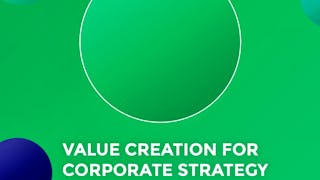In the world of business and organizations, nothing is more important than having an effective strategy. Why? Because without knowing our destination, we cannot determine the right path to get there. This course introduces the two sides of a strategy: competitive strategy and corporate strategy. Competitive strategy has to do with the environment in which firms and organizations are operating and how they can develop and sustain their competitive advantage. On the other hand, corporate strategy has to do with the specific strategies firms undertake to sustain their competitive advantage, such as product diversification, internationalization, and non-market strategies.



What you'll learn
Core strategy concepts that forms the basis of business strategy and shape strategic decisions for sustaining a competitive advantage.
Skills you'll gain
Details to know

Add to your LinkedIn profile
June 2025
21 assignments
See how employees at top companies are mastering in-demand skills

There are 4 modules in this course
This module presents the basic tenets of strategy—what it is and what it is not. We will draw on the work of Professor Michael Porter, whose ideas have been widely implemented by consulting firms, policymakers, and organizations (large and small) worldwide. The key concept to understand is competitive advantage, as it forms the basis of business strategy. We will unpack the concept of competitive advantage in the context of the value chain, presenting the two main paths toward achieving competitive advantage and considering how economies of scale and economies of scope play into our strategy game.
What's included
1 video15 readings5 assignments2 discussion prompts3 plugins
In this module, we will learn one of the most popular frameworks to analyze strategy, Porter's Five Forces. This framework helps learners understand how the competitive forces in an industry shape a company's strategy and profitability. It highlights how competition (industry rivalry) is driven by multiple factors, including the threat of new entrants, the bargaining power of suppliers and buyers, and the threat of substitutes on a company's ability to succeed. By analyzing these forces, you will be able to advise companies in developing strategies to either defend against competitive pressures or exploit opportunities to gain an edge over rivals. Ultimately, Porter's Five Forces helps us strategize in positioning a company to minimize threats and maximize growth opportunities within its industry environment.
What's included
1 video8 readings4 assignments1 peer review6 plugins
Understanding the macro environment is crucial in strategy because it shapes the broader context in which organizations operate, influencing both risks and opportunities. Strategic decisions that ignore these external forces can lead to misalignment with market realities and long-term failure. To systematically analyze these external influences, strategists often use a framework known as the PESTEL model. This tool helps identify key environmental factors that may impact an organization's performance and strategic direction.
What's included
12 readings8 assignments2 plugins
Corporate strategy refers to the choices leaders make and the actions they pursue to gain a competitive edge across various industries and markets at the same time. It answers the critical question: where should we compete? This type of strategy defines a firm's boundaries in three key areas: vertical integration (its involvement in different stages of the industry value chain), diversification (its range of products and services), and geographic scope (the regions or countries it operates in, whether local, national, or international). Strategic leaders must shape corporate strategy by considering all three of these dimensions.
What's included
1 video11 readings4 assignments3 plugins
Earn a career certificate
Add this credential to your LinkedIn profile, resume, or CV. Share it on social media and in your performance review.
Instructor

Offered by
Explore more from Business Strategy

Coursera Instructor Network

University of London

IE Business School
 Status: Free Trial
Status: Free TrialUniversity of Virginia
Why people choose Coursera for their career





Open new doors with Coursera Plus
Unlimited access to 10,000+ world-class courses, hands-on projects, and job-ready certificate programs - all included in your subscription
Advance your career with an online degree
Earn a degree from world-class universities - 100% online
Join over 3,400 global companies that choose Coursera for Business
Upskill your employees to excel in the digital economy
Frequently asked questions
Access to lectures and assignments depends on your type of enrollment. If you take a course in audit mode, you will be able to see most course materials for free. To access graded assignments and to earn a Certificate, you will need to purchase the Certificate experience, during or after your audit. If you don't see the audit option:
The course may not offer an audit option. You can try a Free Trial instead, or apply for Financial Aid.
The course may offer 'Full Course, No Certificate' instead. This option lets you see all course materials, submit required assessments, and get a final grade. This also means that you will not be able to purchase a Certificate experience.
When you purchase a Certificate you get access to all course materials, including graded assignments. Upon completing the course, your electronic Certificate will be added to your Accomplishments page - from there, you can print your Certificate or add it to your LinkedIn profile. If you only want to read and view the course content, you can audit the course for free.
You will be eligible for a full refund until two weeks after your payment date, or (for courses that have just launched) until two weeks after the first session of the course begins, whichever is later. You cannot receive a refund once you’ve earned a Course Certificate, even if you complete the course within the two-week refund period. See our full refund policy.
More questions
Financial aid available,


